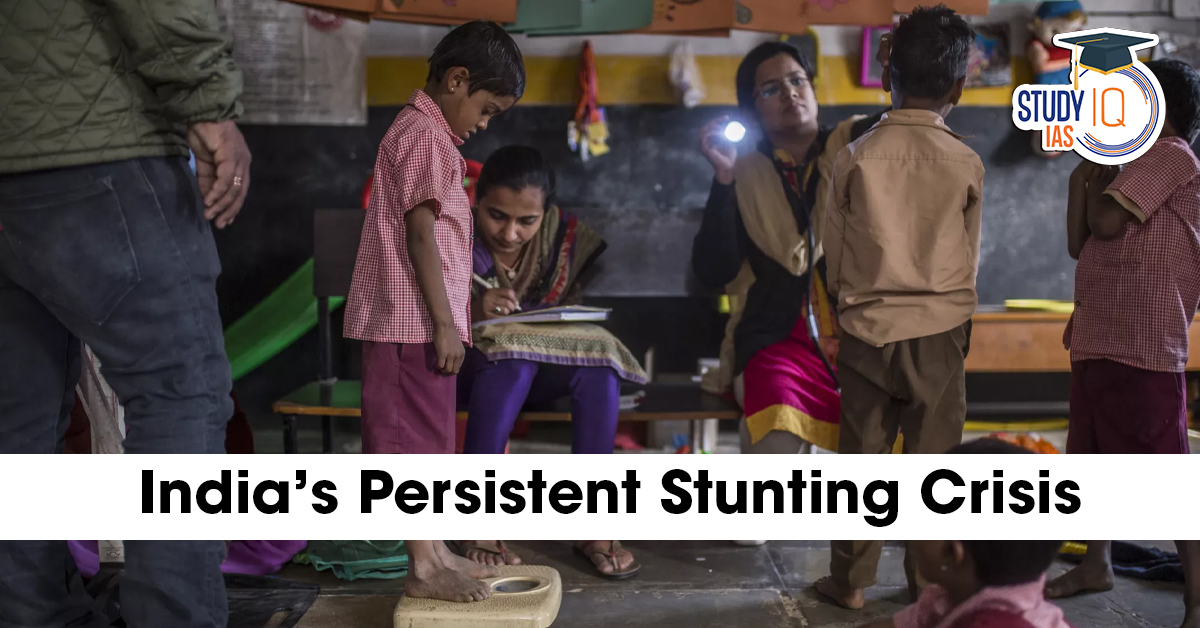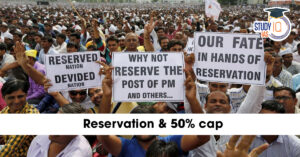Table of Contents
Context: According to NFHS-5 (2019–21), 5% of children under five in India are stunted, reflecting chronic malnutrition. Despite initiatives like POSHAN Abhiyaan (2018) and the target of Mission 25 by 2022, progress has been minimal, highlighting a deep-rooted nutrition crisis.
Why India’s Stunting Crisis Persists – A Complex Web of Factors
- Maternal Health & Teenage Pregnancies: Around 7% of women aged 15–19 had begun childbearing (2019-21).
- Adolescent mothers face higher risks of underweight babies and poor child care.
- Poor Maternal Nutrition & Anaemia: 57% of women (15–49 yrs) and 67% of children under five are anaemic.
- Low nutrient intake (iron, folate, protein) impacts foetal growth.
- Inadequate Infant & Young Child Feeding: Only 64% of infants under six months are exclusively breastfed.
- C-sections (22% of births in 2021) disrupt early breastfeeding and colostrum feeding.
- Only 11% of children (6–23 months) meet the minimum acceptable diet.
- Poor Diet Quality: Carbohydrate-heavy meals dominate, with very low intake of protein and micronutrients.
- Limited access to eggs, pulses, vegetables, and milk in poor/Adivasi households.
- Educational Divide: 46% of children born to mothers with no schooling are stunted vs. 26% for mothers with 12+ years of schooling.
- Education influences antenatal care, nutrition, and delaying early marriage.
- Unsafe Sanitation & Water: 19% of households still practice open defecation.
- Poor sanitation leads to diarrhoea and gut infections, reducing nutrient absorption (enteric dysfunction).
What Can Be the Solution for the Stunting Crisis in India?
- Strengthening Maternal Health & Nutrition: Focused interventions for adolescent girls: iron-folic acid supplements, school-based nutrition programs.
- Prevent child marriage and early pregnancies through stricter enforcement and awareness.
- Improving Infant & Child Feeding Practices: Promote exclusive breastfeeding (first 6 months) and timely complementary feeding.
- Reduce unnecessary C-sections and ensure breastfeeding support in hospitals.
- Ensuring Diet Diversity: Universal provision of eggs, pulses, and micronutrient-rich foods in ICDS/Anganwadi and Mid-Day Meals.
- Scale-up biofortification (iron-rich millet, zinc-rich rice).
- Tackling Anaemia: Expand Anaemia Mukt Bharat with mass deworming, iron supplementation, and dietary diversification.
- Education & Women’s Empowerment: Incentivise girls’ secondary education.
- Integrate nutrition awareness into school curriculum and self-help groups.
- Water, Sanitation, and Hygiene (WASH): Strengthen Jal Jeevan Mission and Swachh Bharat Mission to eliminate open defecation and unsafe drinking water.
Conclusion
India’s stunting crisis is not merely a nutrition issue—it is the outcome of an interlinked web of maternal health, education, diet, sanitation, and socio-economic deprivation. While POSHAN Abhiyaan created momentum, its targets remain unmet because interventions were fragmented. A holistic, life-cycle approach—starting from adolescent girls’ health, maternal care, diet diversity, WASH, and women’s education—is critical. Only then can India break the intergenerational cycle of malnutrition and unlock its demographic dividend.


 Geo-tagging of Buildings During Upcoming...
Geo-tagging of Buildings During Upcoming...
 Gender Gap in Educational Expenditure in...
Gender Gap in Educational Expenditure in...
 Reservation and 50% Cap: Constitutional ...
Reservation and 50% Cap: Constitutional ...

























